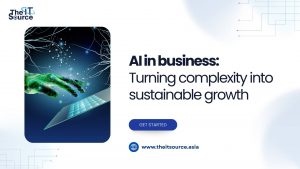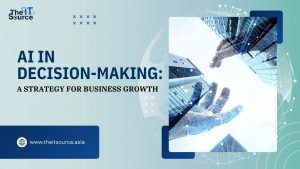Top offshore development center trends for 2025

For today’s business leaders, the mandate is clear: innovate relentlessly or risk becoming irrelevant. Yet this ambition often collides with a stark reality: a global shortage of specialized tech talent. This is where the offshore development center (ODC) has been redefined. No longer just a cost-saving tactic, the modern ODC is a strategic growth engine. It enables enterprises to unlock scalability, drive innovation, and ensure compliance on a global scale.
The scale of this shift is undeniable. The global IT outsourcing market is projected to exceed $512 billion by 2030 (Statista), underscoring the central role ODCs now play in enterprise strategy. For industries such as finance and logistics, where regulatory demands are uncompromising, ODCs offer a safer, compliance-first path to scale. At The IT Source (TIS), we partner with forward-thinking companies in Japan and Europe to build dedicated offshore teams that go beyond coding. Our teams deliver operational efficiency while navigating complex frameworks such as GDPR and the new EU AI Act.
As 2025 approaches, a new wave of offshore development center trends is emerging. In this guide, we explore the key shifts every leader must watch. These trends are vital to staying competitive and achieving sustainable growth.
Trend 1: The rise of hybrid offshore development models
For years, the choice for leaders seemed binary: keep your team in-house for control or go offshore for scale. Today, however, that difficult trade-off is dissolving. The hybrid model is emerging as the new strategic standard. It blends the best of both worlds: local strategic oversight combined with global engineering capacity. This is not just a theory; it is a widely adopted strategy. In fact, Deloitte’s 2025 Global Business Services Survey highlights that leading organizations are actively combining internal and offshore talent to accelerate their digital transformation.
This “compliance-first” framework is especially powerful in regulated industries like finance and logistics. It allows companies to ring-fence sensitive functions, such as data governance and checks for GDPR or EU AI Act compliance, securely in-house. This approach frees offshore development centers to focus on their strengths. They can accelerate innovation and scale products faster.
The hybrid model is among the most influential offshore development center trends for 2025. It offers a clear blueprint for responsible scaling and proves that companies no longer have to sacrifice security for speed.
Trend 2: The pursuit of specialized offshore development expertise
The era of using an offshore development center for general coding capacity is ending, as enterprises now pursue specialized expertise in high-impact domains like artificial intelligence, cloud-native architecture, and cybersecurity. These are the capabilities that build a lasting competitive advantage, not just incremental improvements. This strategic pivot is supported by Statista data, which shows that a primary driver for IT outsourcing is to access specialized skills unavailable in-house. It signals a fundamental evolution: ODCs are now regarded as hubs of deep technical knowledge, not just sources of cost-efficient labor.
This strategic shift is most pronounced in high-stakes industries. Financial institutions now seek partners who can fortify their operations with advanced regulatory technology, while logistics enterprises demand specialists in predictive AI to unravel complex supply chains. Ultimately, specialization has become one of the most decisive offshore development center trends for 2025. It empowers organizations to scale intelligently, innovate with precision, and build lasting resilience in a competitive global market.
Trend 3: Enhanced collaboration tools and communication
For an offshore development center to act as a true extension of an in-house team, seamless collaboration is essential. This is powered by a modern tech stack: real-time communication platforms like Slack and Microsoft Teams eliminate distance. While project management hubs like Jira and Asana create a single source of truth for tasks and progress. The ROI on this integration is significant. According to McKinsey, companies that fully embrace these tools can see productivity gains of 20 to 30 percent. This level of improvement is fundamentally redefining the potential of distributed offshore development center teams.
The impact goes far beyond efficiency. These tools establish a new standard of operational transparency. Enterprises can monitor progress in real time, anticipate risks early, and align global teams with the cohesion of a single-office environment. Advanced collaboration has become a defining feature of offshore development centers, turning modern tools into a core strategic enabler for innovation, consistency, and trust in 2025.
Trend 4: Emphasis on data security and compliance
As offshore development centers expand their role in larger and more complex projects, data security has become an absolute priority. With regulations such as GDPR in Europe and the upcoming EU AI Act, enterprises expect their offshore partners to uphold the same rigorous standards as their internal teams. The financial stakes are immense. IBM’s 2023 Cost of a Data Breach Report revealed that the average global cost of a breach has reached $4.45 million, illustrating why security cannot be an afterthought when scaling globally.
In this environment, compliance is no longer just a legal checkbox; it is a cornerstone of trust. Leading offshore development centers prove their commitment by embedding advanced security protocols, including end-to-end encryption, zero-trust architecture, and continuous threat monitoring. This focus on robust data protection is one of the most critical offshore development center trends for 2025. It transforms security from a constraint into an enabler. This shift ensures rapid innovation can coexist with the full assurance of compliance.
Trend 5: AI and automation as the new ODC backbone
In the modern offshore development center landscape, one decisive trend stands out. It is the integration of artificial intelligence and automation. These technologies are no longer just tools; they are becoming the operational backbone of ODCs. They now span the entire development lifecycle. AI accelerates code testing and bug detection, while automation streamlines workflows and reduces time-to-market. The macroeconomic impact is significant. PwC projects that AI will contribute up to $15.7 trillion to the global economy by 2030, driven largely by productivity gains. For businesses partnering with offshore development centers, this is an opportunity to harness that same power. It helps enhance scalability and adapt to market shifts in real time.
The most transformative impact is on human capital. By automating routine tasks that once consumed valuable developer hours, AI frees engineers. They can now focus on innovation and complex problem-solving. This shift redefines the role of offshore development centers, evolving them from task execution units into strategic innovation partners. As a defining part of the offshore development center trends shaping 2025, AI integration enables enterprises to scale smarter, reduce operational friction, and maintain a competitive edge in fast-changing markets.

Trend 6: Talent shortage and remote work evolution
The global shortage of skilled tech talent continues to challenge enterprises. By 2030, Korn Ferry estimates there will be a shortfall of more than 85 million skilled workers worldwide, representing a potential loss of $8.5 trillion in unrealized annual revenues. Offshore development centers have become a vital solution to this crisis. By tapping into diverse talent pools across Asia, Eastern Europe, and Latin America, ODCs provide access to critical expertise that may be unavailable in local markets.
Remote work has accelerated this evolution. The normalization of distributed teams allows offshore development centers to integrate seamlessly with in-house staff. This creates flexible structures that can scale up or down based on project needs. This trend reduces dependency on local talent markets while increasing resilience against disruptions. As part of the broader offshore development center trends shaping 2025, the combination of global talent sourcing and remote collaboration is enabling enterprises to overcome shortages, maintain quality, and remain competitive.
Trend 7: The shift toward strategic, long-term partnerships
The market is maturing. Leading enterprises are moving beyond short-term, transactional contracts and toward strategic, long-term partnerships with their offshore development centers. The logic is simple: true value comes from a partner who understands the business deeply, not just a vendor who completes a ticket. This focus on continuity and shared goals is confirmed by Deloitte’s global outsourcing survey, which found that 57 percent of organizations now prioritize long-term collaboration and cultural fit.
When an offshore development center evolves into a true extension of the team, the benefits compound over time. An ODC partner begins to anticipate needs, integrate seamlessly with internal workflows, and proactively contribute to the innovation roadmap. This deep trust fosters smoother communication and creates a more resilient delivery model. This focus on lasting partnerships is a defining offshore development center trend. It enables businesses to scale sustainably. It also creates a durable competitive advantage that is difficult to replicate.
Building your future-ready offshore strategy
As we look to 2025, the evidence is clear: the offshore development center has evolved far beyond a tactical cost-saving measure. The trends from hybrid models and deep specialization to AI integration and long-term partnerships mark a new era where ODCs serve as engines for innovation, compliance, and resilience. By embracing these offshore development center trends, executives can ensure their global strategies are future-ready.
At TIS, we are built for this new era. We partner with companies in Japan and Europe to design hybrid teams, provide specialized AI and automation expertise, and operate with a compliance-first mindset that ensures peace of mind. Our mission is to help you build an offshore strategy that delivers not only immediate efficiency but also durable, long-term growth.
Contact our team today to explore how a partnership with TIS can turn these trends into your competitive advantage.


 日本語
日本語
